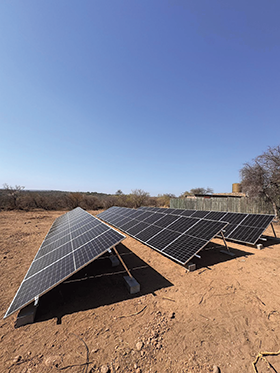
Solar energy is surging in South Africa, and according to PwC, the country recently added over 4400 megawatts of solar panels, excluding government procurement and utility-scale installations. Much of that capacity sits in the commercial and industrial sectors, according to the CSIR. But the energy is primarily self-consumed, meaning many manufacturing sites draw power directly and don’t gain more energy independence through comprehensive energy storage or hybrid energy solutions.

Why is that the case? According to Eduardo Werninghaus, CEO at WEG Africa, the answer comes down to three areas: cost, reliability and support. “Manufacturers are big solar adopters. South Africa’s industrial parks have many panels on their roofs. But that’s often still at the surface level. The capital costs associated with justifying energy projects often deter them from installing more comprehensive systems. Many manufacturers would increase their use of solar if they had more reliability and support, especially in energy storage and hybrid power,” he says.
Why manufacturers limit their solar adoption
Panels coupled to an inverter can help a manufacturer supply some of its lighter operational energy needs. However, to power heavier machinery and processes that can run 24/7, solar has limitations. The most obvious is the reliance on sunlight. There is no sun at night and even cloudy days bring notable dips in energy generation. Another limitation involves certain types of machinery that require slow starts or experience dramatic swings in power usage. Many manufacturers still see solar as a complementary energy source, not a viable alternative to grid-based energy. This is because they lack access to the expertise that delivers and supports adequate energy solutions.
“Comprehensive solar and energy solutions are more specialised,” says Werninghaus. “There are not many brands that can deliver the guarantees customers want to see before they even consider going down that route. But companies like WEG have developed end-to-end capabilities, offering manufacturers energy solutions that help them become truly self-reliant.”

The hybrid energy future
An end-to-end energy solution gravitates around an original equipment manufacturer (OEM) that has established development, production, solution design and deployment excellence across its value chain, from generation, transmission and distribution to load usage and storage. This thread of products and services is important to meet the cost, reliability and support criteria; its three areas overlap with each other, making each crucial to realising value from energy investments.
End-to-end (E2E) OEMs and their networks deliver on those areas:
• Cost: Manufacturers are unlikely to invest in comprehensive energy infrastructure unless they can demonstrate a clear justification. An E2E OEM’s energy value chain covers equipment and materials, engineering and the business expertise to align with a manufacturing customer’s requirements, including space usage, energy fluctuations, compliance and deployment. OEMs such as WEG also reduce costs through economies of scale and local manufacturing.
• Reliability: To justify investment, manufacturers need to know their energy systems will continue to deliver. Reliability needs the right ingredients, from the type and number of solar panels, battery energy storage systems (BESS) and software to manage supply and demand to hybrid designs such as generators and steam turbines. E2E OEMs deliver reliable energy systems because they have access and control over the various components, skills and innovation.
• Support: Without adequate and responsive support for their solar and hybrid systems, manufacturing operations can still end up in the dark. E2E OEMs control their supply chains, especially when they have a robust local manufacturing footprint. They consistently produce components, develop skills and build local networks to ensure reliable maintenance and support.
Solar is an abundant, free source of energy that manufacturers can capitalise on. With the right solution and end-to-end OEM support, manufacturers can avoid being vulnerable to power outages. They can build a buffer against rising energy prices and take their seat in Africa’s energy transition.
For more information contact WEG Africa,

© Technews Publishing (Pty) Ltd | All Rights Reserved